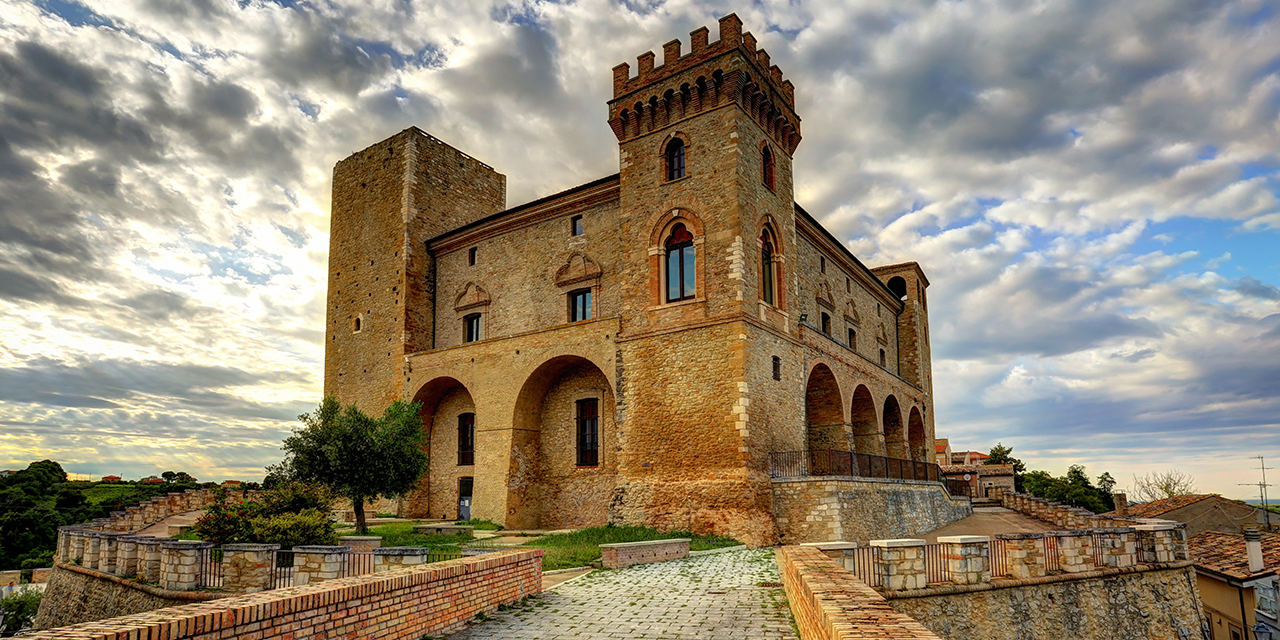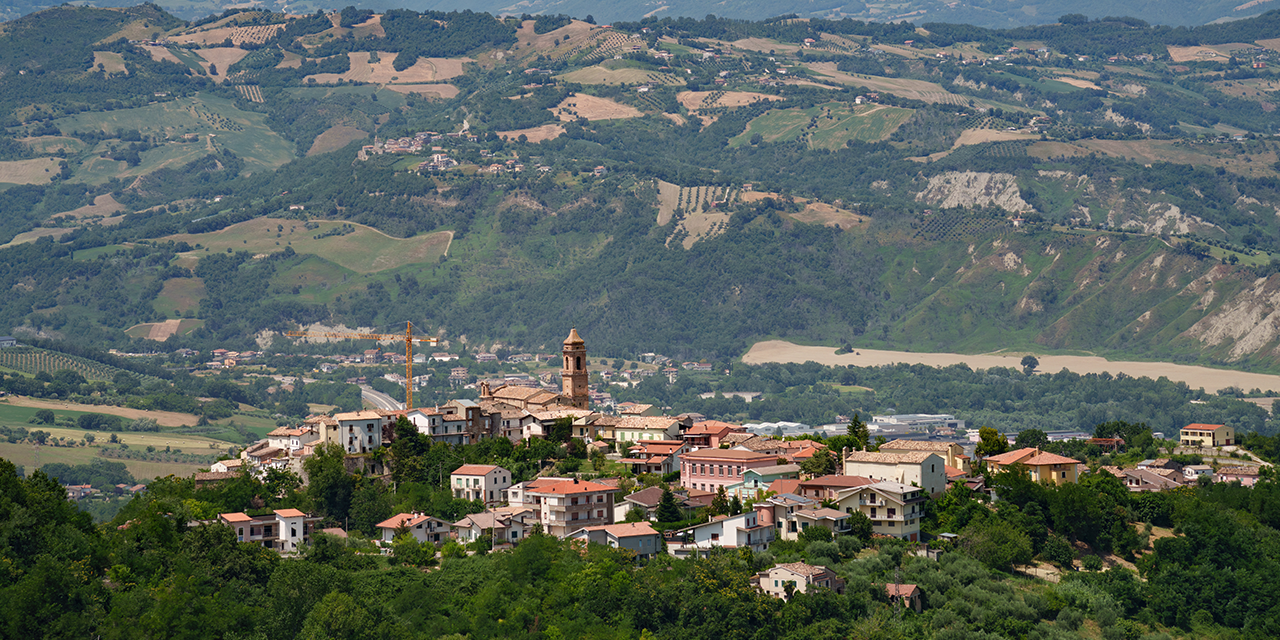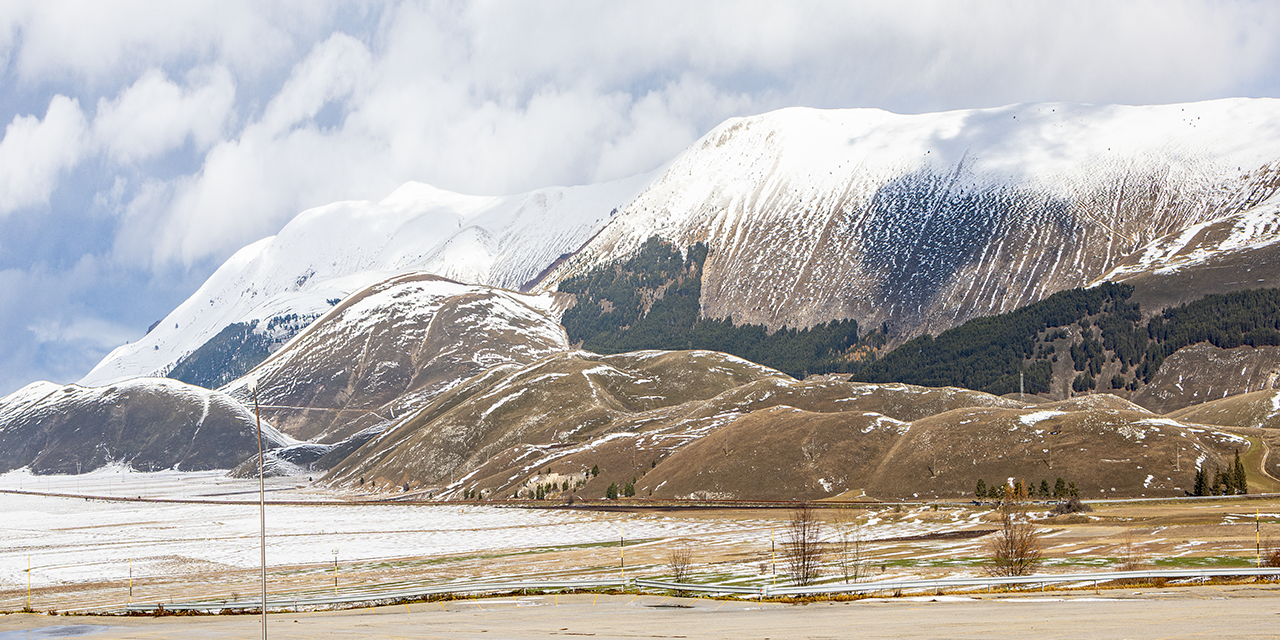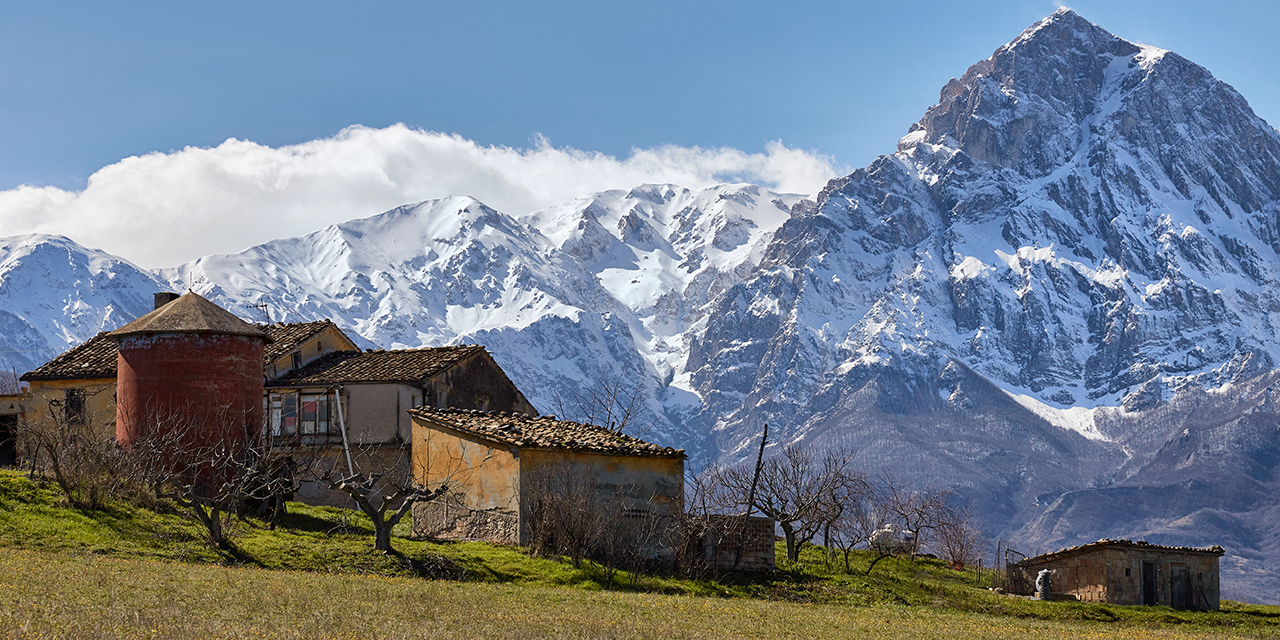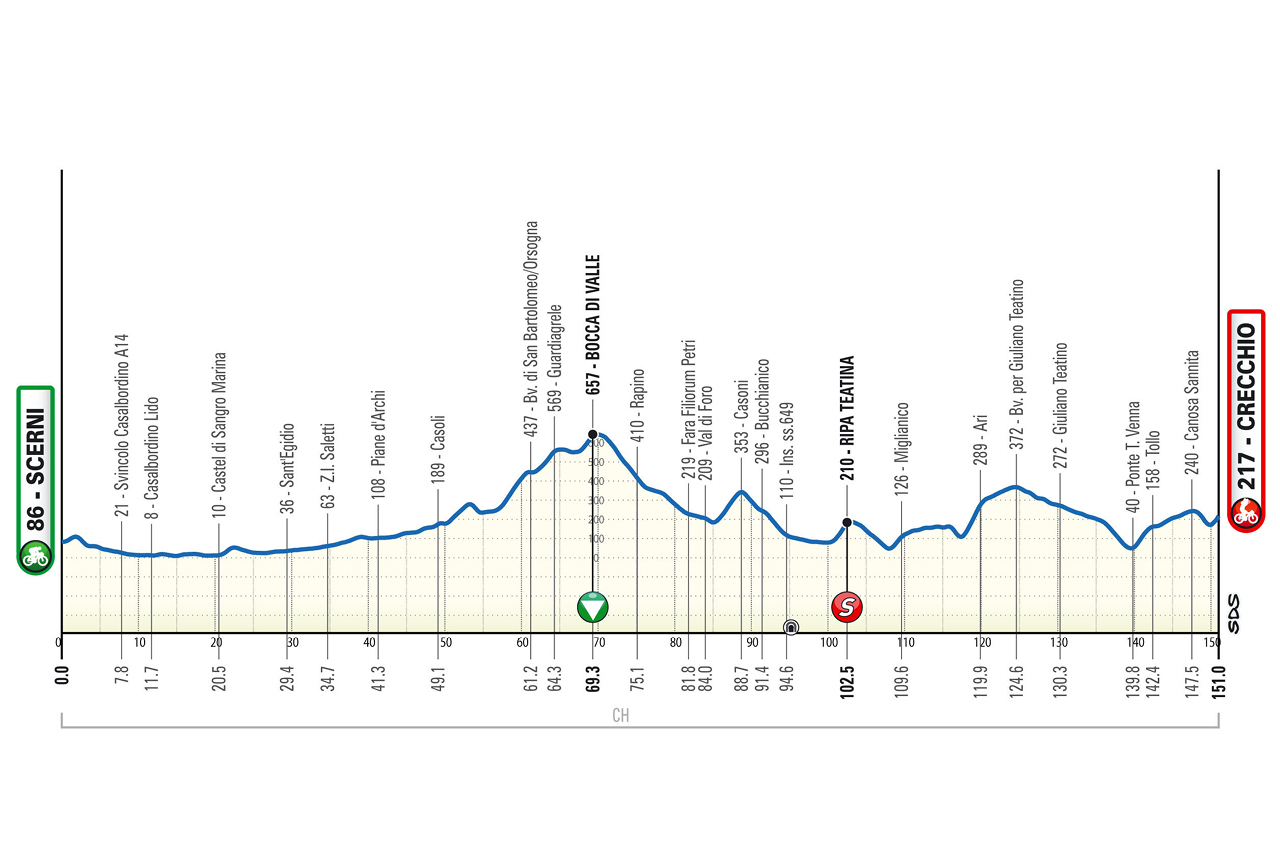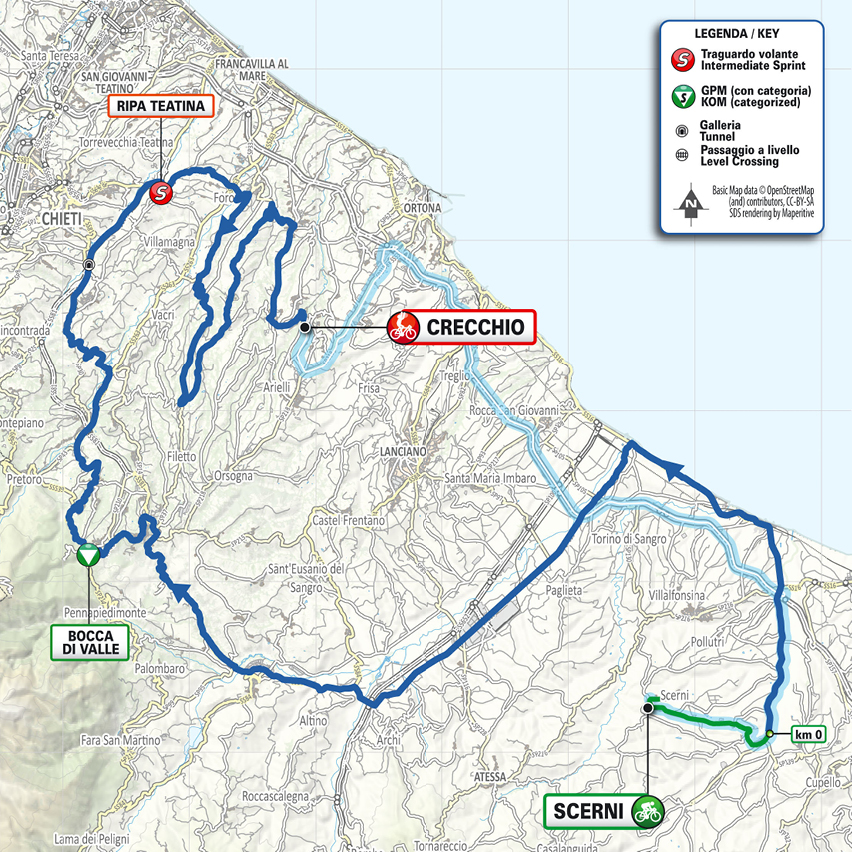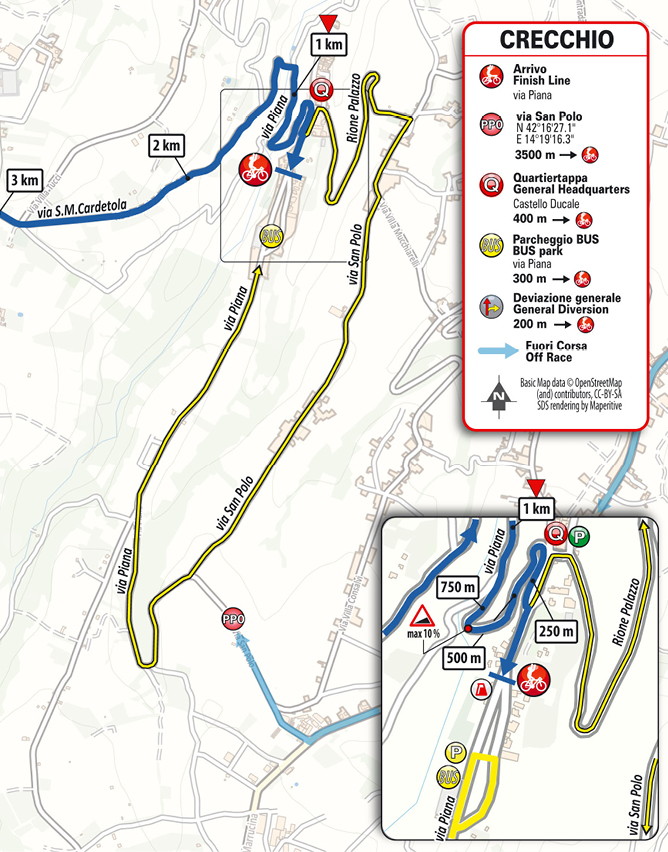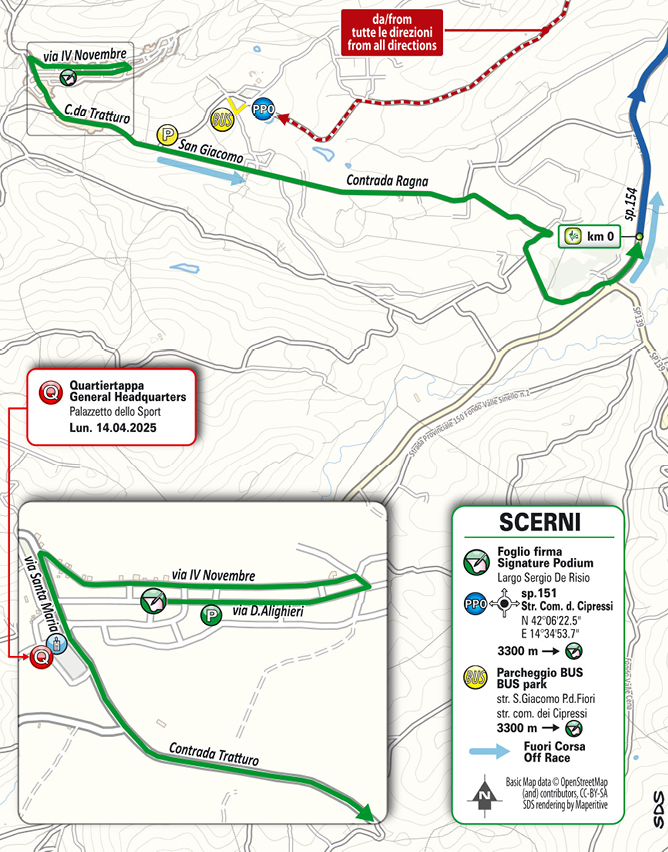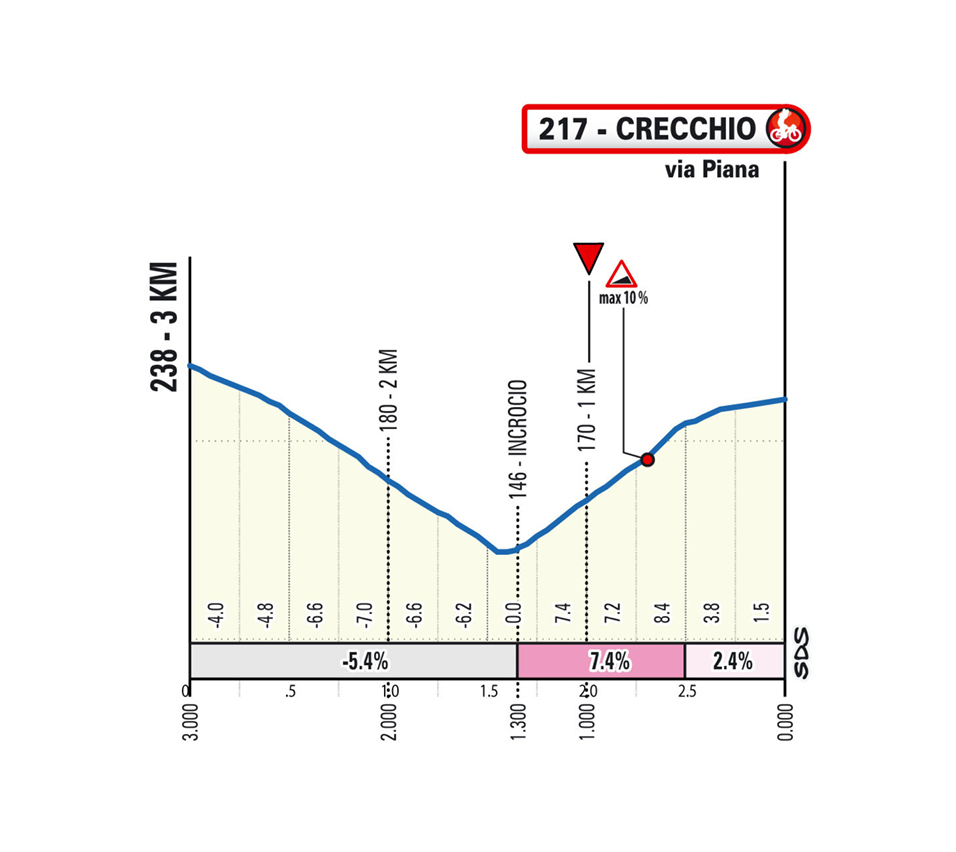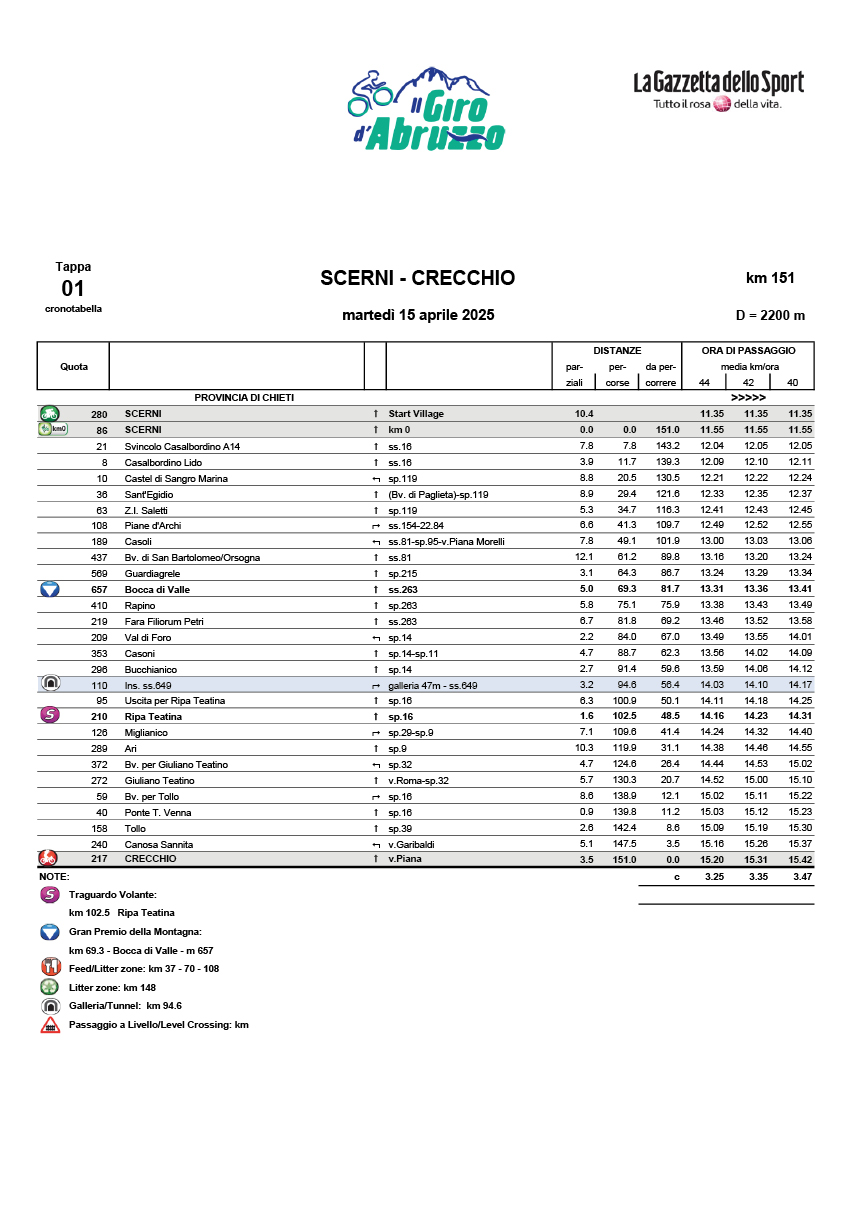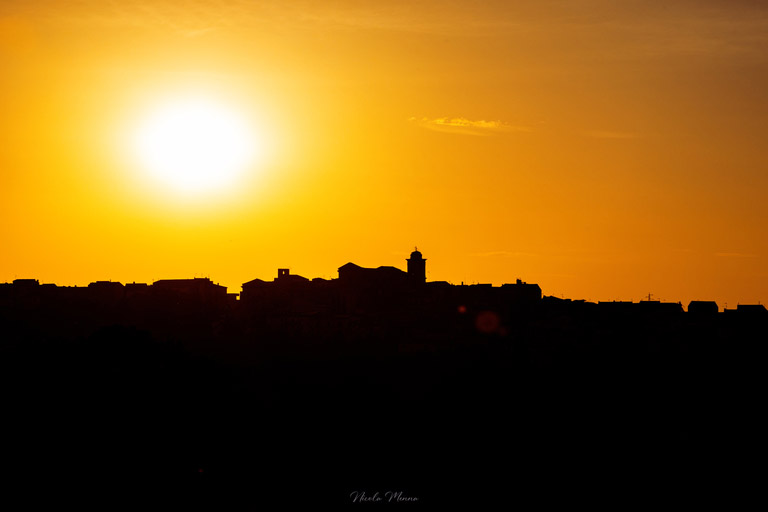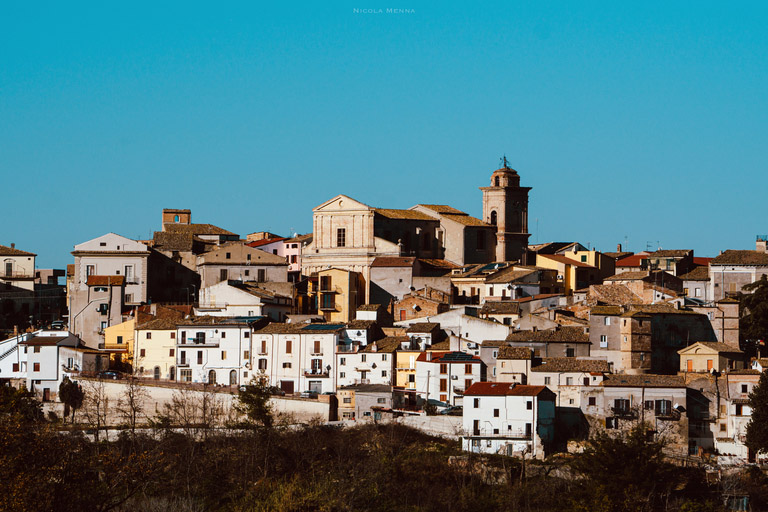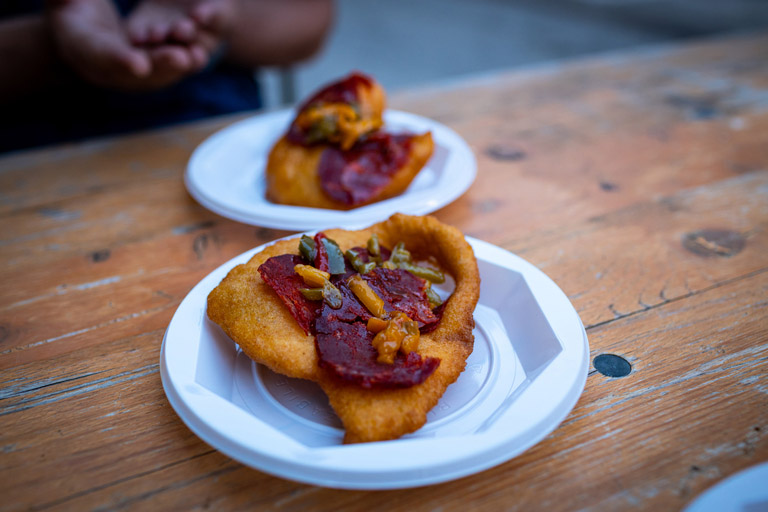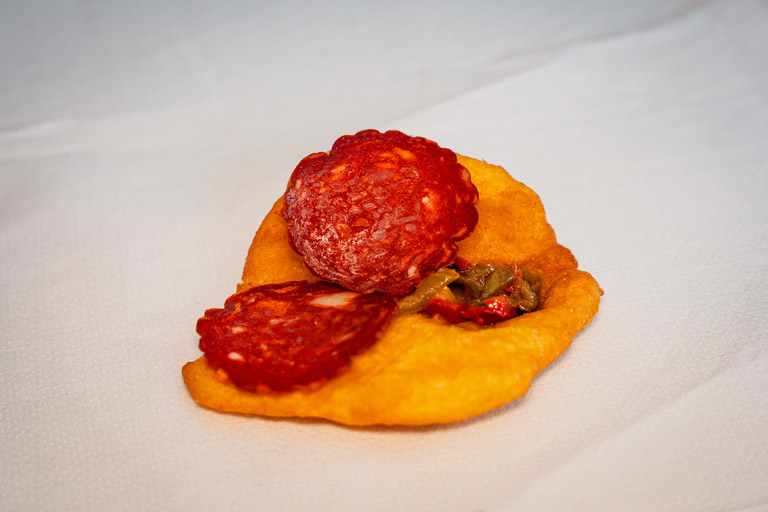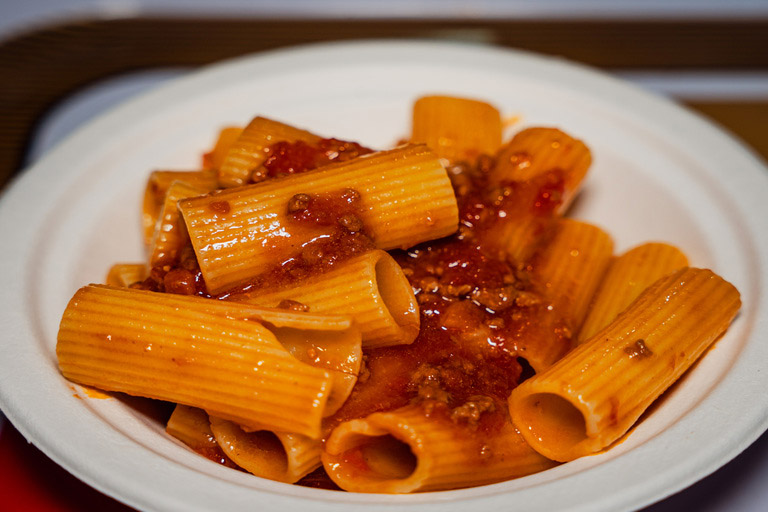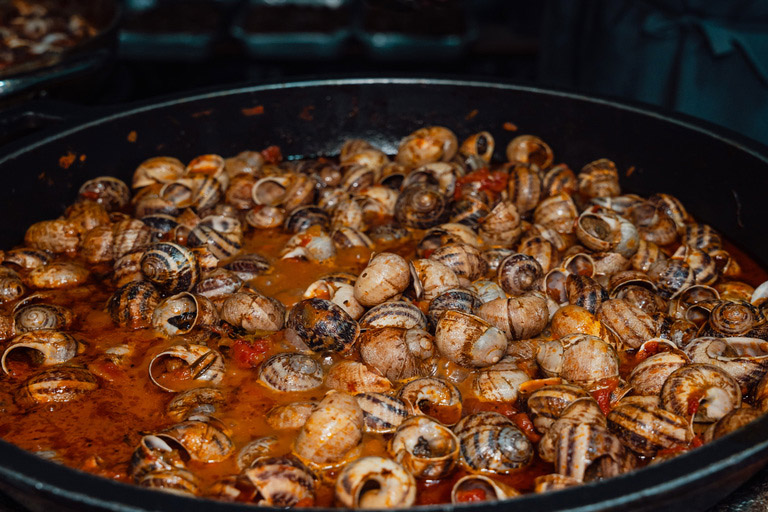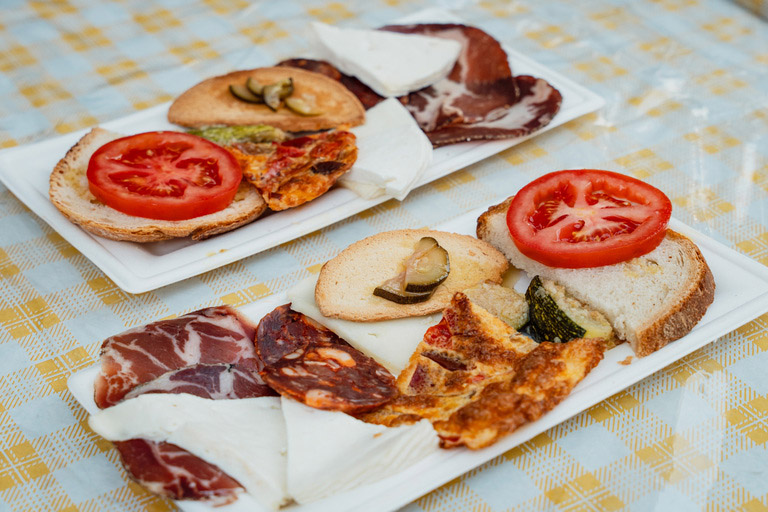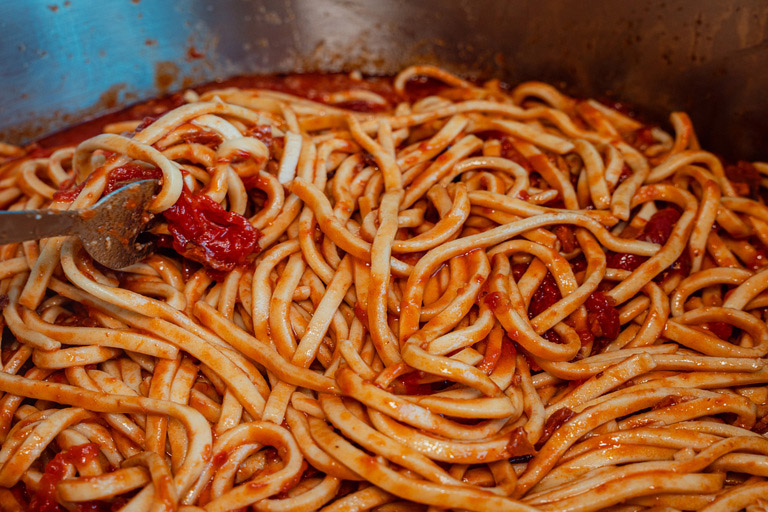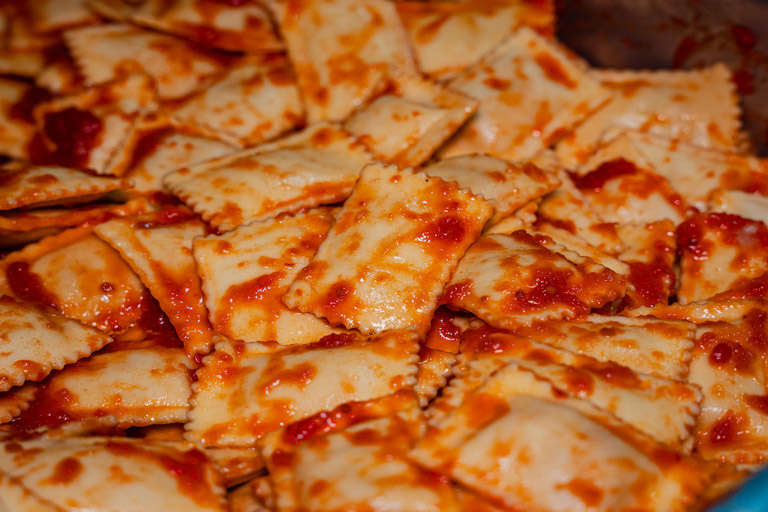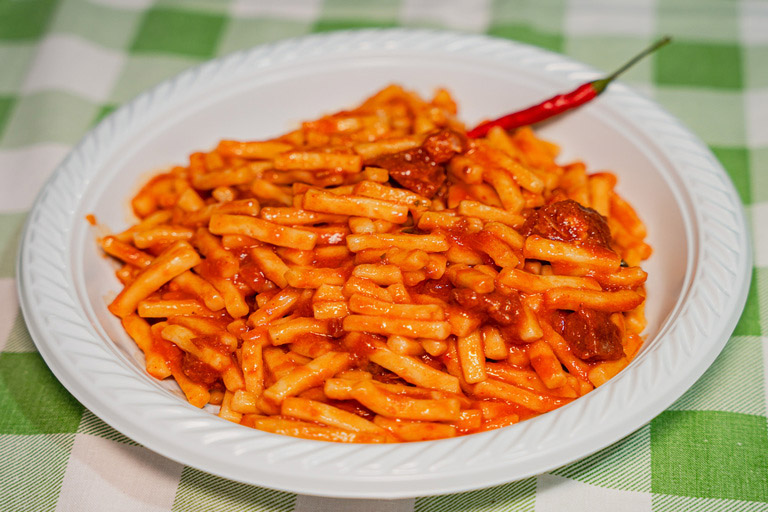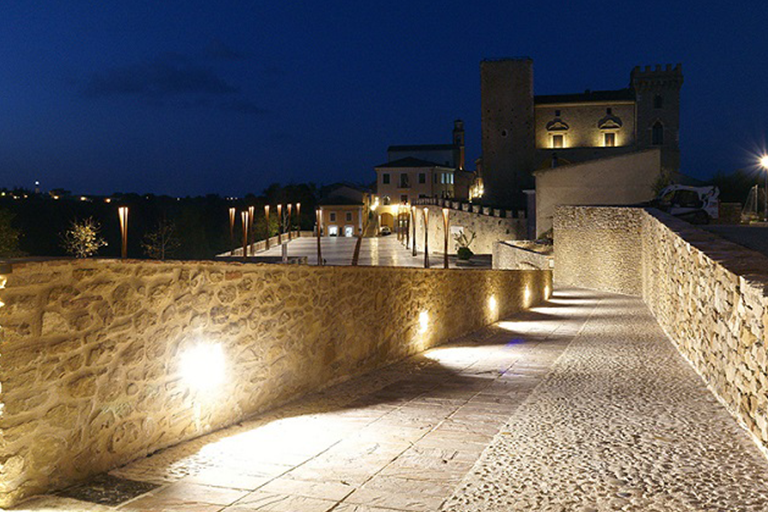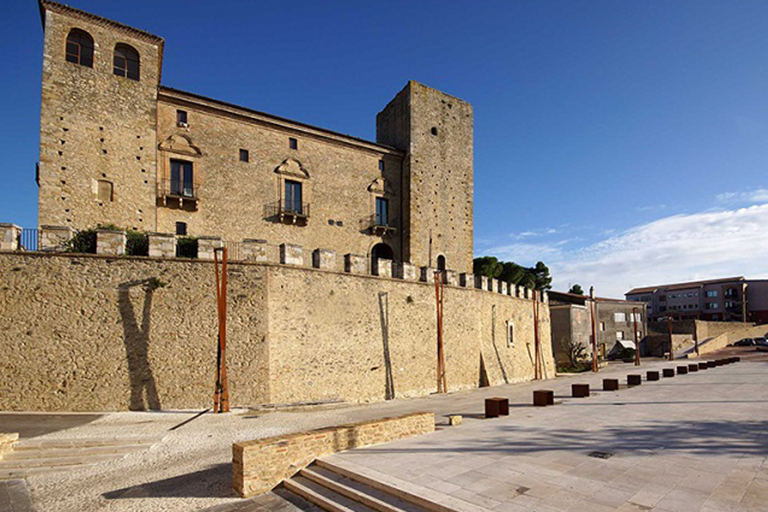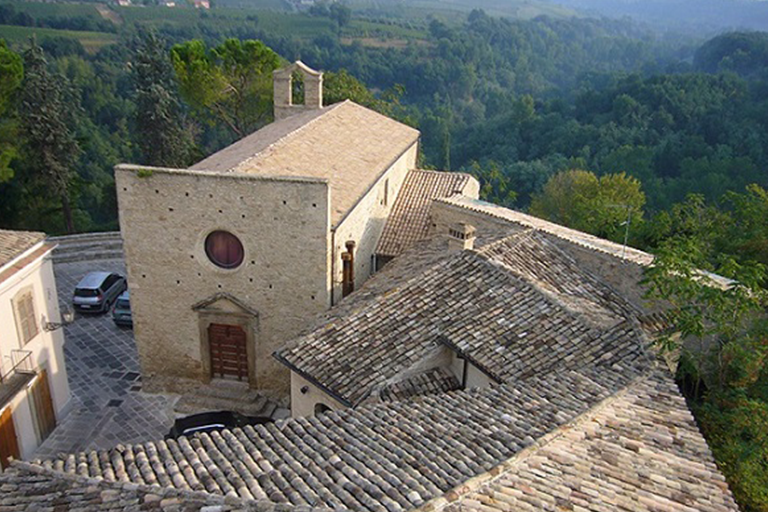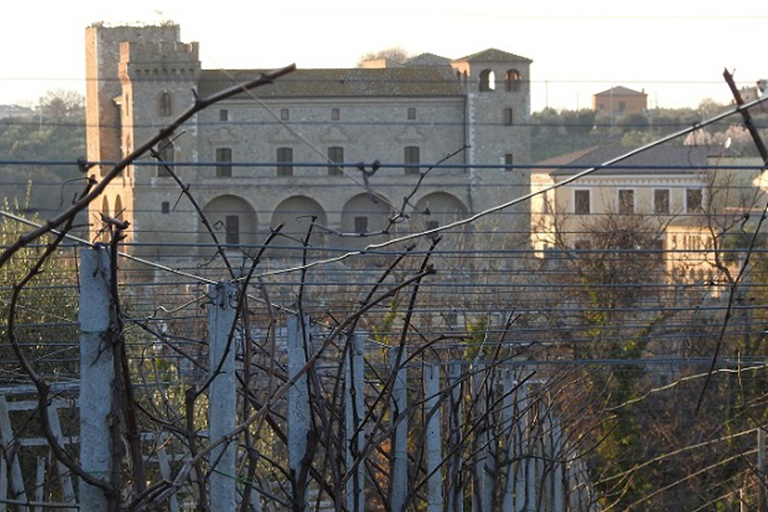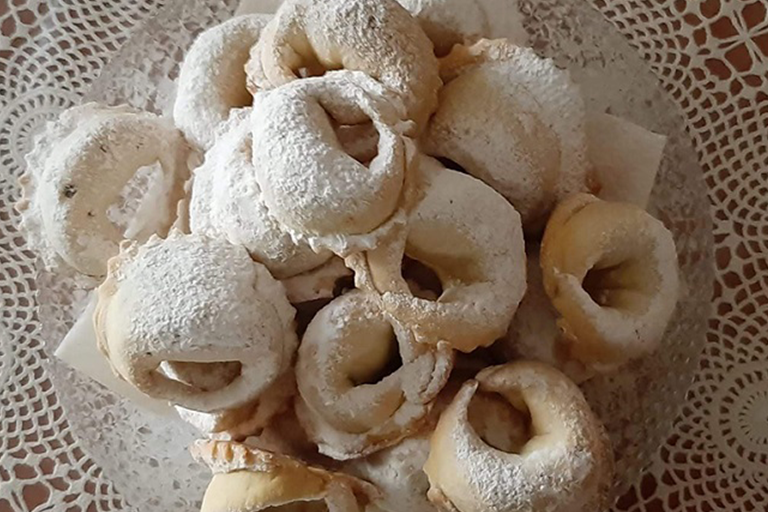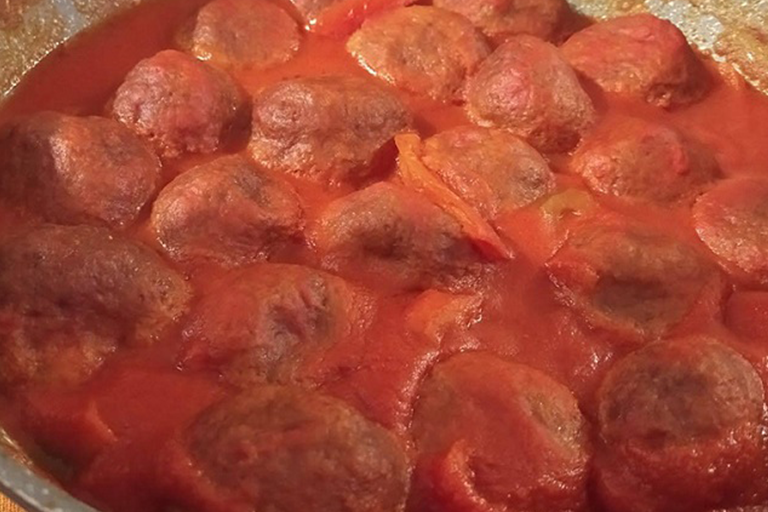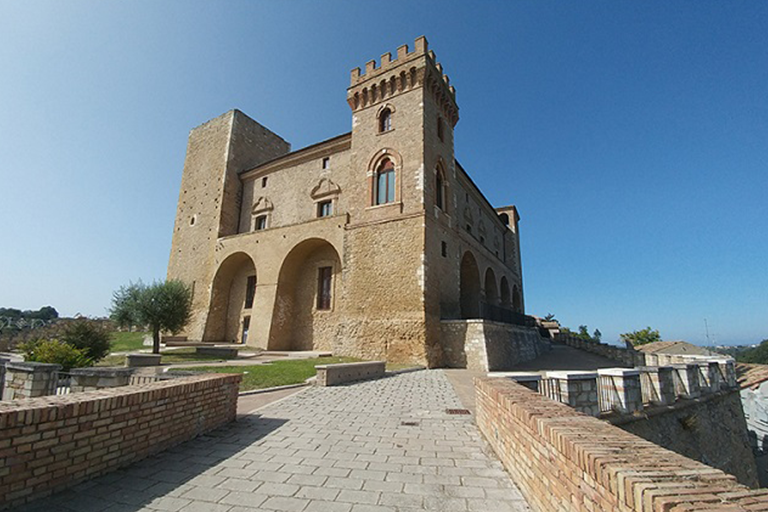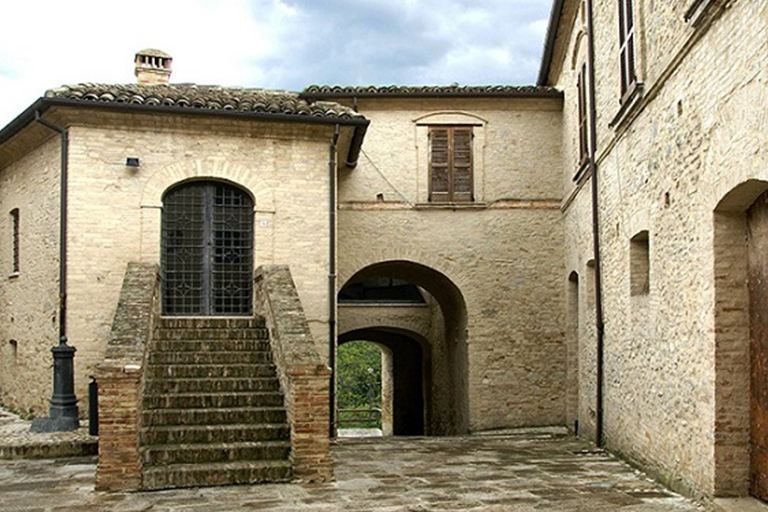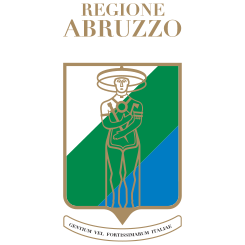learn more
technical info
profile
map
technical info
A rolling stage with an increasingly demanding finale. The first part features a gentle uphill through the inland areas of Chieti province. The peloton then tackles the climb to Bocca di Valle after crossing Guardiagrele. The second half of the stage is less severe but marked by continuous ups and downs and false flats. The roads are challenging, sometimes narrow. Urban sections include typical road furniture like roundabouts, speed bumps, and traffic islands.
Final kilometers
The last kilometers feature a descent followed by a steep uphill ramp (up to 10%) just before the flat final straight. The finish line is on a 200 m stretch of asphalt, 7 meters wide.
start / finish
final kilometres
itinerary timetable
tourist info
Host city:
SCERNI
Overview
Between the often snow-capped mountains of the Maiella National Park and the blue waters of the Adriatic Sea lies Scerni, a small village where history and future blend together in a timeless agricultural landscape filled with flowers, woods, wheat fields, vineyards, and olive groves.
Everything here is tended with passion and care, in pursuit of harmonies that enrich the senses: colors and architecture delight the eyes; nature’s soft sounds soothe the ears; fragrant scents of the land please the nose; and the fruits of the harvest reward the palate. Generation after generation, the people of Scerni have dedicated time and love to this land, preserving its gastronomic traditions with pride and generosity still shared today.
The first mention of Scerni dates back to 883, when the Count of Chieti, Trasmondo II, is believed to have donated the “Castellum Serni” to the monastery of S. Stefano in Rivo Maris. What is certain is that by the 11th century, the “Castellum de Serni” was part of the monastery’s properties, as confirmed by a papal bull from Pope Leo IX in 1503. The strategic nature of the site is clear from the fact that it was previously home to a pre-Roman settlement.
Over the years, archaeological findings across the municipality have revealed traces of human presence dating from ancient times (15,000 to 4,000 years ago) to the medieval period. Scerni also felt the influence of Lombard rule from the late 6th to the 7th century AD. In the centuries that followed, Scerni and the surrounding area gradually passed from Church control into the hands of secular lords. It first became a fiefdom of Raimondo Annecchino, and later was tied to the County of Monteodorisio under Rodrigo d’Avalos and his descendants, remaining linked to that family until the end of feudalism.
The 19th century marked a time of major transformation and significant development for Scerni – economically, politically, institutionally, socially, and culturally. It was one of the most remarkable periods in the town’s long history, perhaps the most important in the past millennium.
As in many neighboring towns, Scerni has also drawn in numerous tourists, especially foreigners, who fall in love with the place and purchase homes to renovate, with the goal of returning more and more often, further proof of the area’s exceptional quality of life. Perched on the ridge of a gentle hill, Scerni is a village with ancient and deep roots. Shielded to the rear by the majestic Maiella range, its historic center opens onto a sweeping valley, offering a view that seems to bow in quiet admiration toward the Adriatic Sea, just a few kilometers away.
Gastronomy
Scerni hosts one of the most important carnivals in the Abruzzo region, along with food and wine festivals that highlight the local area and revive traditions. One such event is “Le ruelle de lu paes”, a vibrant celebration of heritage, culture, and local cuisine held each August in the charming alleyways of the historic village, attracting thousands of participants. Another standout event is “Ventricina e bollicine,” which has grown in stature and shines a spotlight on producers of the area’s signature cured meat, ventricina, as well as local sparkling wines, an increasingly valued sector in the region’s pursuit of quality and flavor.
Crecchio
Overview
Crecchio is a charming little village in the province of Chieti. It is part of the prestigious club of “Italy’s Most Beautiful Villages” (i Borghi piu’ belli d’Italia), a recognition that highlights its historical, artistic and scenic heritage. Its location offers breathtaking views over the Arielli River valley to the Adriatic coast with a glimpse of the Maiella and Gran Sasso massifs.
Crecchio is a place where history, art and nature blend with harmony. The historic centre offers a peaceful and authentic atmosphere, ideal for those who wish to immerse themselves in Abruzzo’s history and culture.
Its origins date back to the time of the Safini, an ancient Italic population, later named Frentana. The village has undergone several dominations over the centuries, including that of the Byzantines, the Lombards and the Normans.
The symbol of Crecchio is the Ducal Castle, which has undergone several transformations over time. The castle is the home of the Byzantine and Early Medieval Abruzzo Museum, which preserves evidence of the Byzantine domination that left an indelible imprint on local art and culture. Evidence can be found in the artifacts preserved in the museum and the historical re-enactment “Dining with the Byzantines”, now at its 17th edition. Crecchio is a charming village, where you can stroll through the narrow streets, admiring the medieval architecture and be enchanted by the beauty of the landscape.
Food
The authentic flavours of Abruzzo dance on the palate, raising the senses to a higher level with their simplicity and authenticity. The cuisine, a hymn to the products of the earth, is a journey into the heart of tradition. The “pallotte cacio e ova”, meatballs of cheese and eggs, fried or stewed, are a childhood memory, a warm and an all embracing feeling. The “pizz’e foje”, a mixture of field vegetables and corn pizza, tells the story of a generous land. The “sagne e fagioli”, a rustic and comforting dish of home made pasta with beans in souce, is a symbol of hospitality in Abruzzo. The “pizza scima”, a yeast-free flatbread baked in a wood-burning oven or covered on the fireplace, brings to mind the flavours of the past, when life was marked by the rhythms of nature. The “arrosticini” skewers of sheep cooked over embers, are a tribute to pastoral tradition, an explosion of intense, wild flavours. The “fiadoni,” cheese-filled pasta caskets, are a symbol of Easter flavours and traditions. The “pasta alla chitarra” with three-meat ragout, a rich and sumptuous dish, is a triumph of flavours that nicely come together in perfect harmony. Local desserts offer an even greater symphony of flavours that not only enchant the palate, but also the soul. Mostaccioli, which are dark, spicy sweets with their intense aroma of cinnamon and cloves, are a reminder of winter festivals. “Tarallucci ripieni”, typically prepared for the Christmas festive period, are offered as gifts to family and friends. They are shaped like small taralli with a filling made of cooked must, dried fruit, chocolate and spices: crispy and fragrant, they are an invitation to conviviality, a dessert to share with friends.
“La Pupa e il Cavallo” are prepared with short pastry enriched with almonds and sometimes with pieces of chocolate. These sweets have ancient origins and are linked to typical Easter rites of fertility and rebirth. The “pizza doce”, a triumph of sponge cake and cream, soaked with alchermes is an explosion of colours and flavours, typical of holidays and special occasions. And pizzelle, crispy and fragrant wafers, with their diamond pattern, are a symbol of local tradition, which narrates the story of the local territory and its people. Oil and Honey are also typical products: extra virgin olive oil, with its intense and fruity flavour, is a gift from the earth, a treasure that enriches every dish. Honey, with its different varieties of flowers is an elixir of sweetness, a gift from nature that enchants the palate.
La pupa e il Cavallo sono preparati con pasta frolla arricchita da mandorle e talvolta cioccolato. Questi dolci hanno origini antiche e sono legati a riti di fertilità e rinascita, tipici della Pasqua. La pizza dolce, un trionfo di pan di spagna e crema, con bagna all’alchermes è un’esplosione di colori e sapori, tipico delle feste e delle occasioni speciali. E le pizzelle, cialde croccanti e profumate, con il loro disegno a rombi, sono un simbolo della tradizione, un dolce che racconta la storia di di un territorio e della sua gente.
Tra i prodotti tipici vi sono anche Olio e Miele: l’olio extravergine di oliva, con il suo sapore intenso e fruttato, è un dono della terra, un tesoro che arricchisce ogni piatto. Il miele, con le sue diverse varietà di fiori, e un elisir di dolcezza, un regalo della natura che incanta il palato.
Wines and Beverage
Crecchio and its surroundings are lands with a vocation for viticulture. Fine wines are produced from the passion and dedication of local winemakers. Among the social wineries, one can find realities that enhance native grape varieties. Family-run private wineries offer wines that best express the characteristics of the territory, with unique aromas and flavours. Wines, that tell ancient stories, are born from the hills of this part of Abruzzo. In these hills, the air smells of wild herbs and the sun caresses the grapes. Pecorino, with its name evoking flocks on transhumance, gives scents of tropical fruit and broom, a freshness that tastes of mountain wind. Trebbiano, rooted in the territory for centuries, offers versatile wines with aromas of white flowers and a minerality reminiscent of the land from which it comes. Chardonnay, an international grape variety that finds unique expression here, takes on a golden yellow hue and offers intense, fine aromas. Pinot Grigio, with its understated elegance, offers fresh and light wines. Moscato has Mediterranean origins and brings with it the warmth of the south. Montepulciano, the beating heart of wine-making in Abruzzo, gives intense, fragrant ruby red wines, with scents of red fruits and spices. The embracing softness of Merlot offers wines with scents of cherry and black cherry. Passerina was rediscovered in recent years and brings fresh and savoury wines with scents of citrus and yellow fruit. Last but not least, the elegant aroma of Fiano, that brings notes of dried fruit, completes this sensory journey among Abruzzo’s grape varieties.
Points of Interest
Crecchio offers a rich historical and cultural heritage and there are numerous points of interest that are a must.
- Castello Ducale De Riseis D’Aragona: an imposing medieval fortress which dominates the historical centre of the village and is the home to the Byzantine and Early Medieval Museum of Abruzzo. Its structure dates back to as early as the 12th century, with later modifications. The museum displays artefacts of great historical and artistic value, evidence of the Byzantine and early medieval period, the pre-Roman period and the Etruscan civilisation. One can admire a fine selection of interior and exterior furnishings in the historical section of the castle, which are evidence of the splendour that characterised the early 20th century. Evocative images also offer a glimpse into the vibrant social life of the time, allowing visitors to immerse themselves in the atmosphere of that period. The Norman tower dating from the 12th century is worth visiting.
- Church of Santa Maria da Piedi: currently an auditorium, there are indications of a pre-Roman settlement at this site.
- The historic centre of the Village: a labyrinth of alleys and narrow streets that preserve the atmosphere of an ancient medieval village, with stone houses, arches and ancient portals. The names of the streets are suggestive and recall the history and traditions of the village.
- Ducal Square: recently redeveloped, it is a striking space that opens at the foot of the imposing Ducal Castle, offering a panoramic view of the surrounding landscape and the Maiella in the background.
- Palazzo Monaco: a fine historic building, built on earlier medieval ruins, its current appearance as a noble palace can be traced to building works that go back to the second half of the 17th century, now a testament to local aristocratic architecture used as a catering facility for weddings and other important events.
- Porta da Piedi: located on the northern side, it fits into the context of the ancient walls and fortifications that surrounded the historic centre and is one of the ancient fortified entrances to Crecchio.
- Church of Santa Elisabetta: Shrine where ex-votos and a wooden statue of the Saint dating back to the 14th and 15th centuries are preserved.
- Church of Saint Saviour: Parish church dedicated to the Most Holy Saviour. The earliest mentions of the church, dated 1153 and 1176, indicates that it was dedicated to St. Angelo. Comparison with other archaeological sites suggests the possibility that the cult of St. Angelo (Archangel Michael) replaced an older one dedicated to Hercules. Noteworthy are the altar, ambo and tabernacle in white marble sculptural works by Maestro Tonino Santeusanio.
Crecchio is also an ideal starting point for excursions to Majella National Park and for visiting the Adriatic coast.
Photos Stage 01
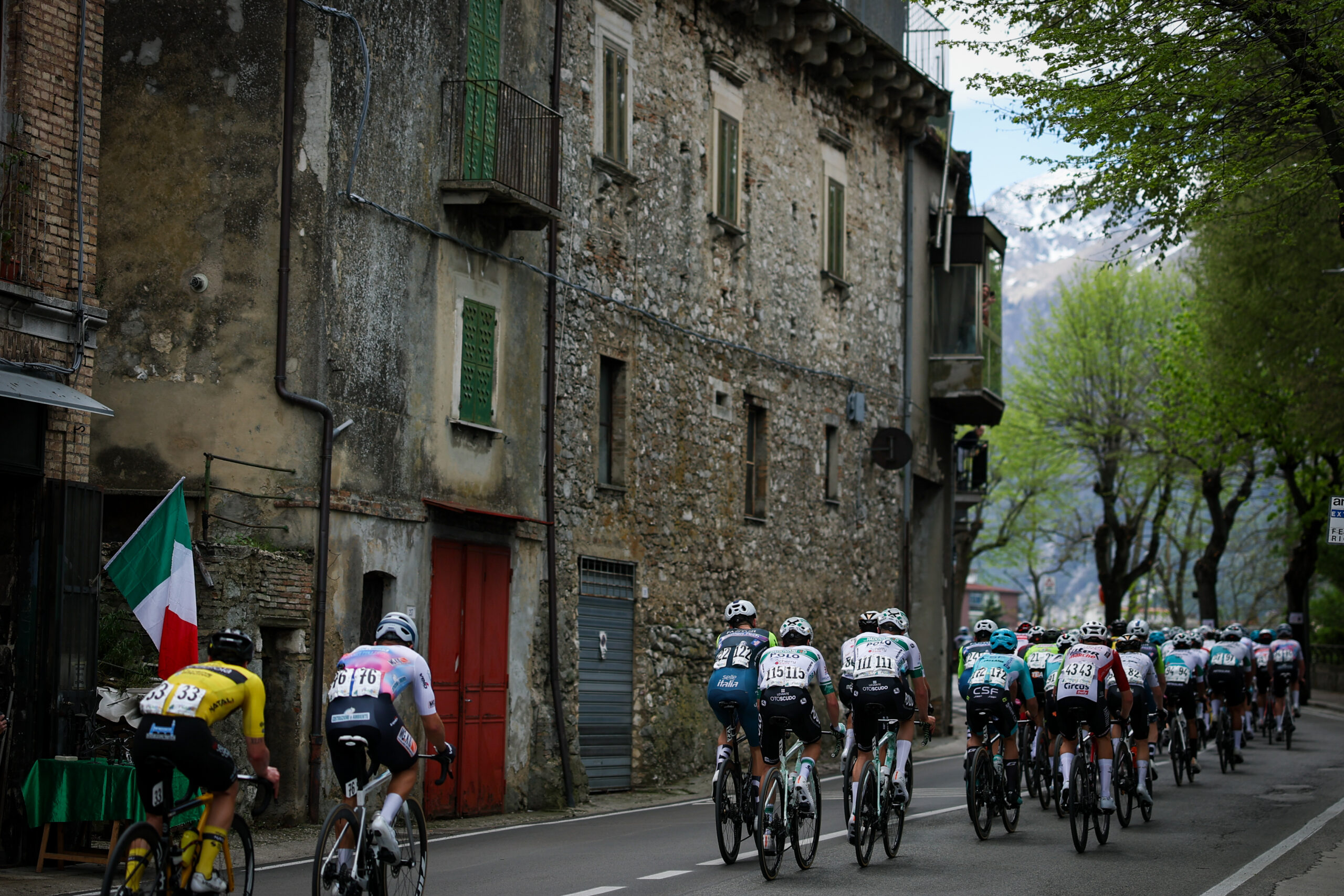
Il Giro d'Abruzzo 2025 | Stage 1 | Best Of
15/04/2025

